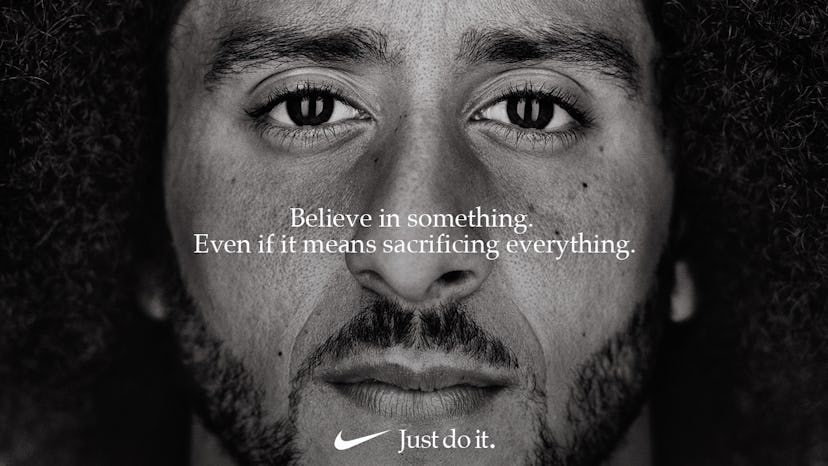The Colin Kaepernick Nike Campaign Is Working

Less than a week after thesportswear giant Nike unveiled its new ad campaign featuring Colin Kaepernick, the NFL quarterback who is currently a free agent and whose protest against police brutality (he knelt during the anthem, but he wasn’t protesting the anthem) made him a controversial figure in the sports world, it looks like the collaboration is paying dividends. Whether Nike’s intention in working with Kaepernick was to support Black Lives Matter, to show the NFL that sponsors are not afraid of politics, to seem “woke” to potential customers, or simply to use a prominent figure to sell gear, it was probably a combination of factors, and the move has been praised for highlighting and promoting an athlete using his platform for good, especially since the NFL has a history of problematic stars. (Cough, cough, domestic abuse.) The numbers are in, and the bottom line is fine.
Despite some conservatives’ claim that they would boycott the brand, “Nike’s online sales grew 31% from Sunday through Tuesday of Labor Day weekend this year. That’s notably better than last year’s 17% seasonal increase,” according to Fortune. And though the president claimed on Twitter that the brand was hurting because of their alignment with Kaepernick and his peaceful sideline protest (Nike stock did briefly drop but has since recovered), Dazed reports that the company was mentioned over 1,000 percent more on social media because of the campaign, and quotes analyst Aaron Goldman, who explains, “You can be darn sure that Nike has done its research and knows what will move its product and who this campaign will resonate with.”
Perhaps most importantly, the cadre of sports stars in the Nike sponsorship family are sticking by the company. The Boston Globe reports that “LeBron James, Serena Williams, and Tom Brady all…appeared to endorse the Nike ad” through social media likes, tweets, and speeches, respectively. Nike doesn’t necessarily need ultraconservative football fans; if it has its athletes and its customers, well, that’s how you sell shoes.
Related: Serena Williams Praises Nike for Colin Kaepernick Ad
A Brief History of Tennis Fashion Controversies
Though the response to the catsuit ban (even saying it out loud, it sounds outrageous) on social media was critical and political, Williams herself took it in stride: “When it comes to fashion, you don’t want to be a repeat offender,” she said in a press conference.
The hemlines of tennis whites have crept up since the 1940s, but at the time, Gertrude Moran’s hint of lace underwear scandalized the tennis world. Ahead of the 1949 Wimbledon tournament—Moran’s first—she had requested permission to wear a colorful look, breaking with the tennis club’s tradition of all-white ensembles. When she was denied her request, she decided instead for a more subversive statement: a lace trim along her underwear, which briefly flashed during play. The All England Tennis club reportedly accused her of bringing “vulgarity and sin into tennis”—and the controversy even had a day in Parliament. To top it off, Moran lost her match.
Ah, the original catsuit. Anne White’s catsuit, which she wore to the championships at Wimbledon in 1985, was designed by Ted Tinling, the same designer responsible for Gertrude “Gussie” Moran’s lace-trimmed underwear. After losing her match to White, Pam Shriver complained to Wimbledon officials about her opponent’s look, and it was banned (even though it adhered to the club’s all-white policy).
After Serena Williams (and others, including men) dared to include a pop of color under her Wimbledon whites, the administration cracked down, forbidding colorful undergarments in 2014. Here, one of the offenders: Williams with hot pink underwear, coordinating with the bright pink piping on her dress.
Two years later, Serena Williams won Wimbledon again, this time matching deep fuchsia undergarments and a headband with the colored piping on her dress. Two years after that, such thoughtful details would be forbidden—because, after all, the (probably old) men who run the tennis establishment don’t want to consider women’s undergarments.
As Shriver illustrates, sometimes tennis looks face criticism from outside rather than inside the administration. Here, a camouflage Adidas look worn by many of the brand’s contracted athletes was designed to “minimize distractions”—for the players wearing the outfits, rather than their opponents.
Similarly, Nike’s uniform for the 2016 Wimbledon tournament was not a favorite among players—too short, too loose—except for a select few, like Eugenie Bouchard, who described it as “nice and short so you can move around and be free with your movements.” Notably, Serena Williams, a Nike athlete, did not wear the dress—because the brand designs her custom looks.
Even a hint of color can send the Wimbledon gods into a frenzy—especially when that hint of color even remotely hints at the needs of women’s bodies. In 2017, Venus Williams wore a pink bra under a Wimbledon-approved all-white look. But after a mid-match rain delay, she came back onto the court without a spot of pink in sight. She declined to address the change during a post-match press conference: “I don’t like talking about bras in press conferences,” she said. “It’s weird.”